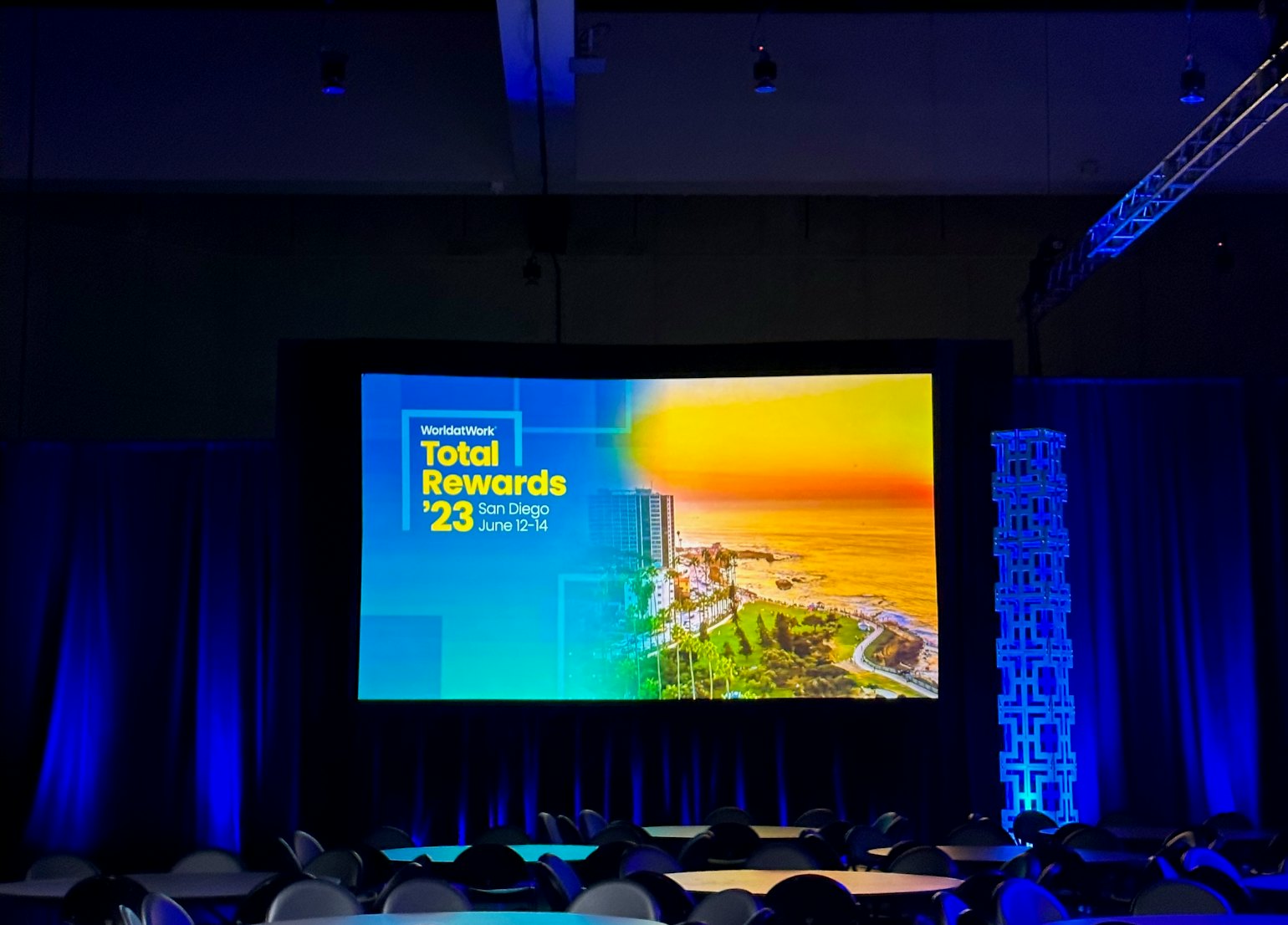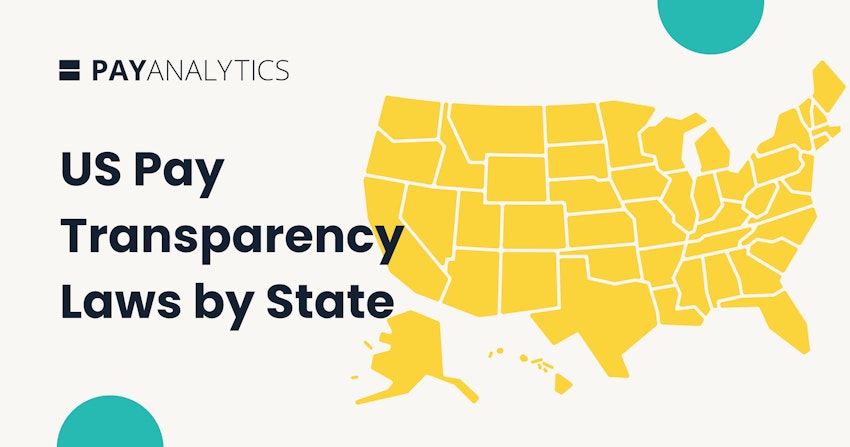WorldatWork’s Total Rewards conference brought together over 1,200 compensation specialists for lively discussion on a wealth of fascinating topics. As we gathered in the convention center, the excitement in the building was almost palpable, and the buzzing energy contrasted the “June gloom” outside (we were hoping for slightly warmer weather, but the locals informed us that it’s not always sunny in San Diego).
This year, the focal point of the conversation shifted from remote work to three major themes: pay transparency, inclusive benefits, and AI/tech in human resources.

Conference stage at Total Rewards '23
Salary transparency shapes fair and equitable compensation
Multiple speakers at the World at Work Conference focused on pay transparency, reflecting its significance in creating equitable compensation practices. By fostering pay transparency, organizations establish trust, enhance employee satisfaction, and promote a culture of fairness. Research by the Institute for Women’s Policy Research suggests that pay transparency reduces the gender wage gap in part by countering “asymmetric wage information, whereby employers know more than workers about pay rates,” which can undermine candidates’ and employees’ power at the negotiating table.
Salary disclosure in job postings, one of many key aspects of pay transparency, has become increasingly prevalent as the discussion of the harms of pay secrecy have entered the mainstream. These laws in the U.S. focus heavily on publishing pay bands, leading employers to ask some tough questions about their pay philosophy.
Approximately 25% of workers in the U.S. will be touched by these laws in 2023. New legislation for pay transparency in the U.S. and around the globe has contributed to the tectonic shift in how companies approach pay in general. For example, E.U. transparency regulations, and state-level legislation have fostered a stronger culture of mindfulness in pay decisions.
Companies must be prepared to embrace this shift by developing transparent and consistent pay structures anchored in a clear compensation philosophy. Practitioners within those companies will be responsible for driving change that could impact their organizations for decades.
But individuals—even managers with decades of experience—need support and training.
Over and over again, expert speakers highlighted the necessity of managerial training in supporting salary disclosure processes. Recent research from Gallup tells us that active, strategic managers create more engaged, effective employees. Speaking from different cultural perspectives (and on different stages), attendees emphasized the need to prepare compensation specialists and managers to have meaningful conversations about pay and benefits with employees—and that starts at the top.
Good analytical tools are key when it comes to elevating pay decisions in preparation for more global pay transparency.
Whom do benefits benefit? Putting employee well-being first
Pay equity and employee benefits are often discussed separately, as if they were neighbors who only casually say hello. But these topics are now gathering under the umbrella of inclusive workplaces. Fair compensation and equitable benefits are interconnected, inseparable.
But who benefits from benefits? Fair, inclusive benefits packages should be designed in a way that considers the needs of diverse employees and promotes their overall well-being. Offering comprehensive healthcare coverage, flexible work arrangements, and parental leave policies can support employees at different life stages and help bridge the gap between work and personal responsibilities.
But, as HR practitioners, we must ask ourselves: Are any groups being left behind?
The differing wants and needs of a multicultural, multigenerational workforce can make designing benefits programs challenging. But expanded benefit programs help employees who haven’t received the support they need to live full, healthy lives.
Attendees underscored, in particular, the importance of scrutinizing and evaluating inclusive medical benefits, especially in the U.S., where healthcare coverage is typically tied to employers and the quality and cost of insurance varies state-by-state, county-by-county.
A few companies, in this vein, shared their experiences of successfully supporting employees in navigating child and elderly care. In addition to a healthier workforce, navigating these choppy waters led to significant time savings, higher retention, and greater employee quality of life.

Margrét Bjarnadóttir in her talk

Total Rewards '23 conference
A trifecta of HR tech talks: Keeping humans in the loop
As in most industries, the ethical use of AI tools was top of mind. By using their HR analytical toolboxes thoughtfully, organizations can optimize their total rewards strategies and drive better outcomes for both employees and the business.
Using people analytics tools fairly
“On the surface, people analytics are straightforward: We collect data, build a model; the model predicts an outcome, and we incorporate that output into our decision-making,” Margret Bjarnadottir, co-founder of PayAnalytics, said in her talk on using people analytics tools fairly. “But this process is not purely objective: Filled with human judgment, bias can enter the process at any point. We have to take deliberate steps to make sure people analytics tools are used fairly and equitably.”
In using such tools, three essential practices were outlined to promote fairness and overcome bias in AI-based tools and people analytics tools that rely upon training algorithms and machine learning:
- Maintain human involvement
- Consider non-data factors
- Implement rigorous monitoring of tools
“The keys are to keep a human in the loop, to incorporate factors not captured in data into the discussion, and to monitor the tools using both statistical and fairness measures."
Emerging AI anti-bias laws
This insightful presentation dovetailed nicely with broader discussions about AI in practice.
AI anti-bias laws are well on their way to becoming the norm. In July 2023, New York will officially roll out Local Law 144 of 2021, or “NYC 144” for regulating the use of AI in hiring practices. The law, among other things, bans algorithms from using protected characteristics (such as race and gender) when making decisions. We expect to see a rise in regulation around these tools as their risks and rewards become more apparent, and they will no doubt be formative in the future of work.
ChatGPT as a resource, not a replacement
ChatGPT is being experimented with in a wide cross-section of HR functions. For example, it can be used to streamline recruitment (down to drafting help wanted ads and resume review), onboarding and training, performance management, HR support (to address employee questions), and to ensure policies and processes are consistently applied and compliant.
But rather than doom-saying ChatGPT as the first step toward human obsolescence in HR (and other domains), the third talk gave a good overview of how to use ChatGPT as a sort of junior college, rather than a tool to make decisions on our behalf. It’s not a surrogate, but a support.
As ChatGPT itself admits, “While AI can automate certain repetitive tasks, provide data analysis, and support decision-making processes, the human element in HR, such as understanding complex employee needs, managing sensitive issues, and building relationships, remains crucial.”
Success story: How iFood used data to power total rewards
We were really astonished by the variety and quality of sessions at Total Rewards 2023, but some of our best moments were hearing about the successes of those around us, the impact that pay analytics and equity efforts can make on people’s lives.
Improved data availability is changing the speed at which interesting analyses and systems are tested and implemented. It’s getting faster everyday. We’re able to code faster, test faster, iterate faster, release faster; and once these tools make their way into a world that now measures its data in scores of zettabytes, their potential to transform HR is unparalleled.
In Brazil, the food delivery overnight sensation iFood implemented a data-driven merit review. Their data infrastructure had been presciently built to support rapid integration with new tools and systems that hadn’t yet been adopted (or built). Leveraging a range of significant data elements, such as time since last raise, peer group standing, and performance, the project aimed to improve the objectivity of HR decisions and to secure fairer outcomes.
Within an impressive timeframe of just 22 days, they were able to implement a full data-informed decision support system for their merit review cycle. Interestingly, almost half of that time was devoted to pre-launch testing of the new system.
That, to us, is a significant achievement.
Want to chat about pay equity? We’d love to.
It was a great few days for all involved–and we look forward to meeting many of our new acquaintances again at future conferences and events (here’s looking at you, Total Rewards ‘24 in Cincinnati!). For those who missed us (or whom we missed), we’d love to hear from you.
If you’re interested in supercharging your pay equity efforts to create a more inclusive workplace, set up 30 minutes to chat or send us a message through our form.
In the meantime, surf over to Coffee Talk with Planet Fair #45, where Margrét Bjarnadóttir and Henrike von Platen of FPI Fair Pay Innovation Lab talk in more detail about learnings from the conference and how to carry them forward.





